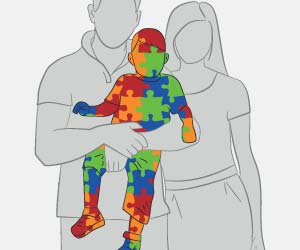Diagnosing autism is now possible with blood and urine tests that can show high levels of dityrosine and advanced glycation end products.
Highlights:
- Certain biomarkers in blood and urine which indicate damaged proteins can help diagnose autism.
- The newly developed blood and urine tests could lead to earlier detection of autism and appropriate treatment can be started much earlier.
- The tests may also help identify the causes of autism.
They found the most reliable of the tests they developed was examining protein in blood plasma where, when tested, children with ASD were found to have higher levels of the oxidation marker dityrosine (DT) and certain sugar-modified compounds called "advanced glycation endproducts" (AGEs).
Autism Spectrum Disorders - Difficult to Diagnose
ASDs are defined as developmental disorders mainly affecting social interaction and they can include a wide spectrum of behavioral problems. These include speech disturbances, repetitive and/or compulsive behavior, hyperactivity, anxiety, and difficulty to adapt to new environments, some with or without cognitive impairment. Since there is a wide range of ASD symptoms diagnosis can be difficult and uncertain, particularly at the early stages of development.
Dr Naila Rabbani, Reader of Experimental Systems Biology at the University of Warwick who said: "Our discovery could lead to earlier diagnosis and intervention." We hope the tests will also reveal new causative factors. With further testing, we may reveal specific plasma and urinary profiles or "fingerprints" of compounds with damaging modifications. This may help us improve the diagnosis of ASD and point the way to new causes of ASD."
The team found a link between ASD and damage to proteins in blood plasma by oxidation and glycation - processes where reactive oxygen species (ROS) and sugar molecules spontaneously modify proteins. They found the most reliable of the tests they developed was examining protein in blood plasma where, when tested, children with ASD were found to have higher levels of the oxidation marker dityrosine (DT) and certain sugar-modified compounds called "advanced glycation endproducts" (AGEs).
The team's research also confirmed the previously held belief that mutations of amino acid transporters are a genetic variant associated with ASD. The Warwick team worked with collaborators at the University of Bologna, Italy, who recruited locally 38 children who were diagnosed as having with ASD (29 boys and nine girls) and a control group of 31 healthy children (23 boys and eight girls) between the ages of five and 12. Blood and urine samples were taken from the children for analysis.
Diagnostic Test For Autism
The Warwick team discovered that there were chemical differences between the two groups. Working with a further collaborator at the University of Birmingham, the changes in multiple compounds were combined together using artificial intelligence algorithms techniques to develop a mathematical equation or "algorithm" to distinguish between ASD and healthy controls. The outcome was a diagnostic test better than any method currently available.
The next steps are to repeat the study with further groups of children to confirm the good diagnostic performance and to assess if the test can identify ASD at very early stages, indicate how the ASD is likely to develop further to more severe disease and assess if treatments are working.
Reference
- Attia Anwar et al., ‘Advanced glycation endproducts, dityrosine, and arginine transporter dysfunction in autism -- a source of biomarkers for clinical diagnosis’. Molecular Autism (2018). DOI 10.1186/s13229-017-0183-3.
Source-Medindia
















